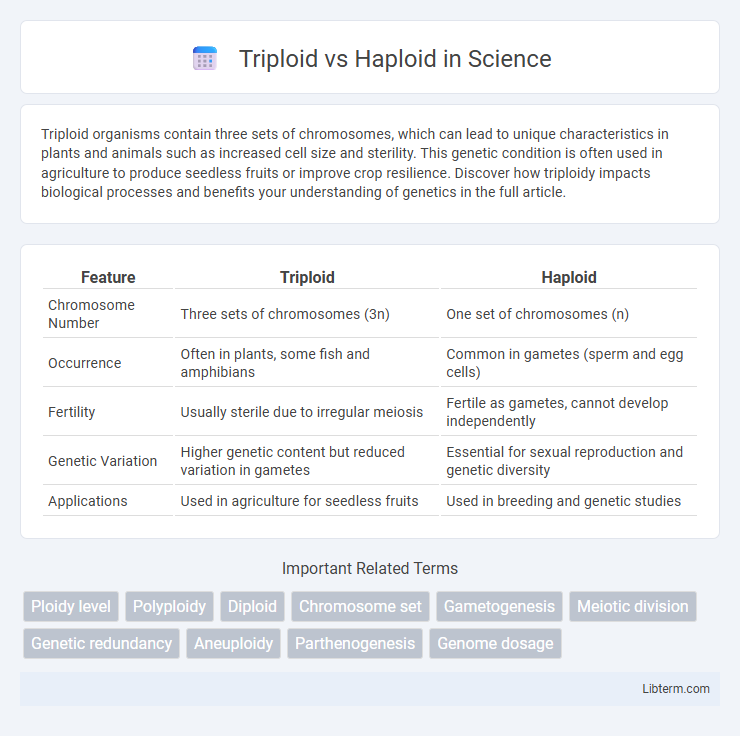Triploid organisms contain three sets of chromosomes, which can lead to unique characteristics in plants and animals such as increased cell size and sterility. This genetic condition is often used in agriculture to produce seedless fruits or improve crop resilience. Discover how triploidy impacts biological processes and benefits your understanding of genetics in the full article.
Table of Comparison
| Feature | Triploid | Haploid |
|---|---|---|
| Chromosome Number | Three sets of chromosomes (3n) | One set of chromosomes (n) |
| Occurrence | Often in plants, some fish and amphibians | Common in gametes (sperm and egg cells) |
| Fertility | Usually sterile due to irregular meiosis | Fertile as gametes, cannot develop independently |
| Genetic Variation | Higher genetic content but reduced variation in gametes | Essential for sexual reproduction and genetic diversity |
| Applications | Used in agriculture for seedless fruits | Used in breeding and genetic studies |
Introduction to Ploidy: Understanding Chromosome Sets
Ploidy refers to the number of complete sets of chromosomes in a cell, with haploid cells containing a single set (n) and triploid cells having three sets (3n). Haploid cells are common in gametes, enabling sexual reproduction, while triploid cells often result from genomic duplication or hybridization and exhibit unique characteristics such as sterility or increased size. Understanding ploidy is crucial in genetics, agriculture, and breeding programs to manipulate and predict organism traits.
Defining Haploid: Structure and Significance
Haploid cells contain a single set of unpaired chromosomes (n), which is essential for sexual reproduction in organisms, ensuring genetic diversity during fertilization. These cells are predominant in gametes, such as sperm and egg cells in animals, and spores in plants, serving as a foundation for forming diploid organisms through the fusion of two haploid cells. The haploid structure simplifies genetic analysis by providing a single copy of each gene, making it a critical phase in the life cycle of many species.
Triploid Explained: Characteristics and Formation
Triploid organisms contain three complete sets of chromosomes, totaling 3n, which results from the fusion of a diploid (2n) and a haploid (n) gamete during fertilization or through chromosome duplication without cell division. This chromosomal configuration often leads to sterility in animals due to irregular meiosis, yet it is advantageous in plants for producing seedless fruits and larger cells. Triploids exhibit unique genetic stability and altered gene expression patterns, which contribute to their distinct physiological characteristics compared to haploids with only a single set of chromosomes (n).
Genetic Differences: Triploid vs Haploid
Triploid organisms possess three sets of chromosomes, resulting in 3n genetic content, whereas haploid organisms contain a single set of chromosomes, denoted as n. The triploid condition often leads to genetic imbalances and sterility due to irregular chromosomal pairing during meiosis, while haploids facilitate the study of recessive traits and genetic mutations because of their single allele per gene. These fundamental differences impact reproductive capabilities, genetic stability, and applications in plant breeding and genetic research.
Occurrence in Nature: Where Are Haploids and Triploids Found?
Haploids commonly occur in fungi, algae, and some plants during their life cycles, facilitating genetic diversity through sexual reproduction. Triploids frequently appear in certain plant species, such as seedless watermelons and bananas, where sterile triploid cells result from the fusion of diploid and haploid gametes. In animals, triploids are rare and usually result from abnormal fertilization events, often leading to developmental issues or sterility.
Reproduction and Fertility: Implications of Ploidy Levels
Triploid organisms contain three sets of chromosomes, which often results in irregular meiosis and reduced fertility due to unbalanced gametes, while haploid organisms have a single chromosome set, enabling straightforward gamete production and higher reproductive efficiency. In plants, triploidy can induce seedlessness, as seen in watermelons and bananas, enhancing commercial value but hindering natural propagation. Haploid phases are crucial in many fungi and algae for sexual reproduction, facilitating genetic diversity and population adaptability through efficient meiosis and fertilization processes.
Agricultural Applications: Benefits and Drawbacks
Triploid plants are extensively used in agriculture for their increased size, seedlessness, and hybrid vigor, which improve crop yield and quality, particularly in fruits like watermelons and bananas. Haploid plants accelerate breeding programs by allowing the rapid production of homozygous lines, facilitating the development of new varieties with desirable traits such as disease resistance and stress tolerance. However, triploids often face fertility issues limiting seed production, while haploids require specialized techniques for induction and maintenance, affecting their large-scale agricultural application.
Biotechnological Uses of Haploid and Triploid Organisms
Haploid organisms, possessing a single set of chromosomes, facilitate rapid genetic analysis and are extensively used in plant breeding and genetic engineering to develop homozygous lines and study gene functions through mutation screening. Triploid organisms, containing three chromosome sets, are primarily employed in aquaculture and agriculture for producing sterile and seedless varieties, such as triploid oysters and seedless watermelons, enhancing commercial value and environmental control. Both haploid and triploid biotechnological applications accelerate crop improvement, pest resistance, and yield optimization by leveraging their unique chromosomal configurations.
Evolutionary Perspectives on Ploidy Variation
Triploid organisms often exhibit reduced fertility compared to haploids due to irregular chromosome segregation during meiosis, influencing evolutionary dynamics by limiting gene flow and promoting genetic isolation. Haploid stages, prevalent in many fungi and algae, facilitate rapid adaptation through direct expression of mutations without dominance masking, accelerating evolutionary responses. Variation in ploidy levels contributes to ecological niche differentiation and species diversification by enabling genome duplication events that introduce genetic novelty and evolutionary flexibility.
Conclusion: Key Takeaways on Triploid vs Haploid
Triploid organisms contain three sets of chromosomes, resulting in genetic complexity and often reduced fertility, while haploid organisms have a single set of chromosomes, leading to simpler genetic expression and easier manipulation in research and breeding. Triploidy is commonly used in agriculture and aquaculture to produce seedless fruits and sterile fish, whereas haploidy is valuable for genetic studies and rapid breeding cycles. Understanding these differences is crucial for applications in genetics, breeding programs, and biotechnology innovation.
Triploid Infographic

 libterm.com
libterm.com